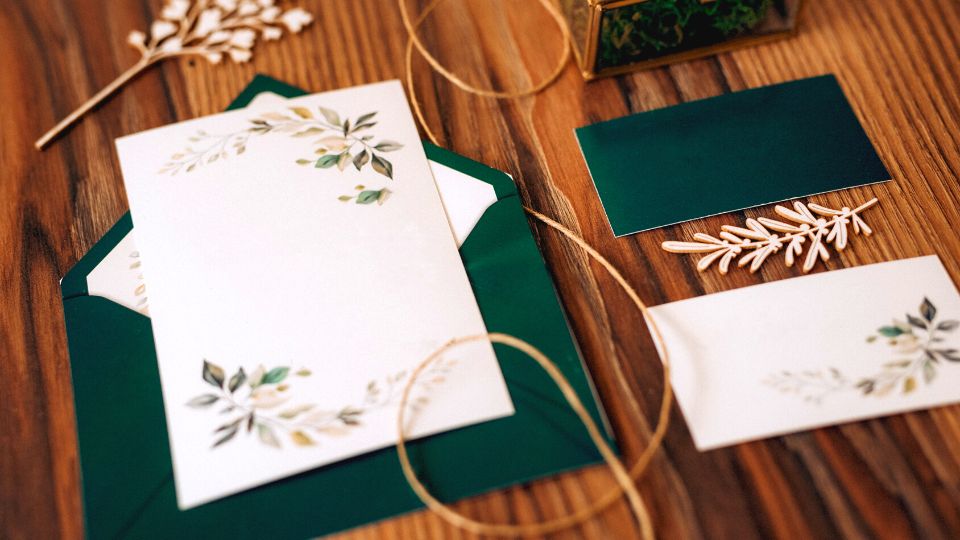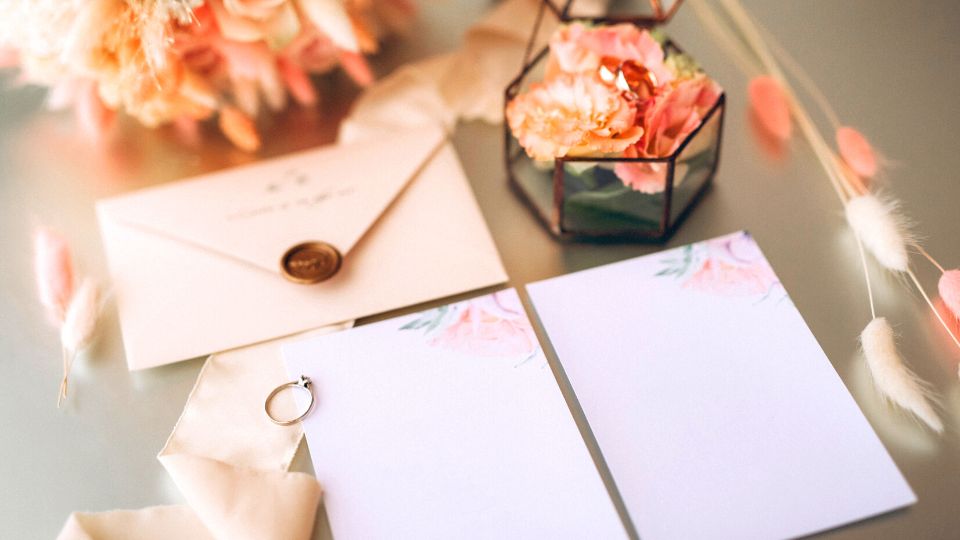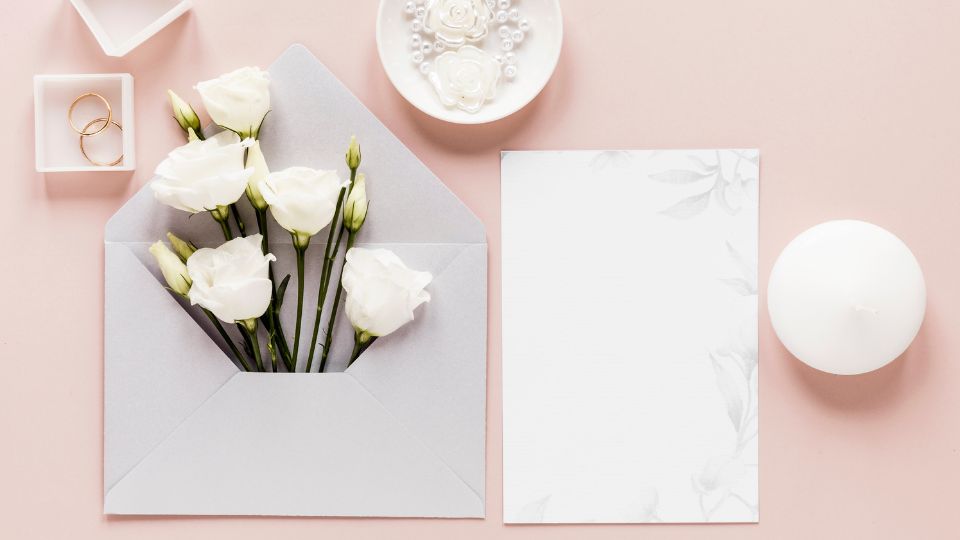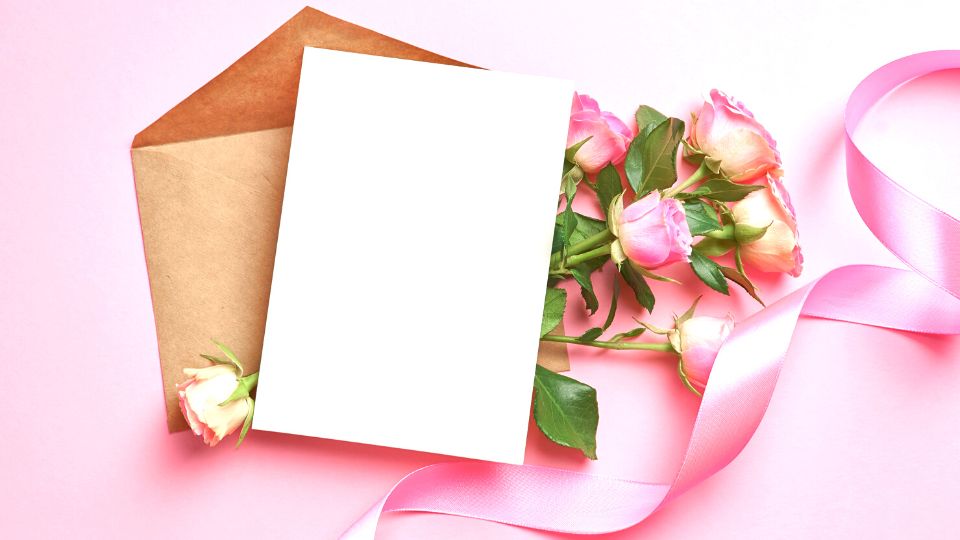When it comes to creating beautiful and elegant wedding invitations, couples have a wide range of printing options to choose from. Two popular methods that are often considered are thermography and letterpress printing.
While both techniques offer unique and stunning results, they each have their own distinct characteristics and advantages.
In this article, we’ll explore the differences between thermography and letterpress printing, their respective pros and cons, and help you decide which method might be the best fit for your wedding invitations.
Thermography Printing
Thermography printing is a type of printing that involves adding a resin powder to the printed ink on the paper. The paper is then heated, causing the resin to melt and create a raised effect on the text and design elements. The result is a three-dimensional texture that looks and feels luxurious.
Advantages and disadvantages
Advantages of thermography printing for wedding invitations:
- Cost-effective compared to other printing methods like letterpress or engraving
- Produces a raised texture that is elegant and sophisticated
- Allows for a variety of paper types and colors to be used
- Can be used for both text and graphic elements on the invitation
Disadvantages of thermography printing for wedding invitations:
- Limited ink colors and designs available compared to other printing methods
- Not as precise or detailed as letterpress or engraving
- Raised texture can make it more difficult to write on the invitation for guests
Examples of when thermography printing may be the best choice
- Formal Weddings: If you are having a formal wedding, thermography printing can add a touch of sophistication to your invitations. The raised lettering created by thermography printing gives the invitations a more classic and traditional look.
- Large Guest List: If you are inviting a large number of guests, thermography printing can be a cost-effective option. It is less expensive than letterpress printing but still gives a similar look.
- Time Constraints: If you have a short timeline for your wedding invitations, thermography printing is a faster process than letterpress printing. It typically takes less time to complete and can be done within a week or two.
- Simple Design: If you have a simple design for your wedding invitations, thermography printing can enhance the look of the text and add a touch of elegance. The raised lettering makes the text stand out and adds a unique texture to the invitation.
Letterpress Printing
Letterpress printing involves pressing ink into paper using a printing press, which creates a debossed impression on the paper. The process begins with a design that is created using digital software or by hand. The design is then transferred onto a printing plate, which is typically made of metal or polymer. The plate is inked and then pressed onto the paper, creating a deep impression that gives the design a three-dimensional feel.
Advantages and disadvantages
Advantages of letterpress printing for wedding invitations:
- High-quality and luxurious feel: Letterpress printing produces a deep impression on the paper, creating a tactile and luxurious texture that is unmatched by other printing methods.
- Customizable: Letterpress printing allows for a high level of customization, from the paper and ink colors to the design and layout of the invitation.
- Durability: The impression created by letterpress printing is not only visually striking but also long-lasting, ensuring that the invitations will remain beautiful and intact for years to come.
- Unique and memorable: Letterpress printing is a distinctive and memorable printing method that can help your wedding invitations stand out and leave a lasting impression on your guests.
Disadvantages of letterpress printing for wedding invitations:
- Cost: Letterpress printing is a labor-intensive printing method that requires specialized equipment and skilled artisans, making it more expensive than other printing methods.
- Limited color options: Letterpress printing is typically limited to one or two colors, which can be a drawback for couples who want a more colorful and vibrant invitation.
- Time-consuming: Because letterpress printing is a time-consuming process that involves multiple steps, it may take longer to produce the invitations than with other printing methods.
Examples of when letterpress printing may be the best choice
- Classic and Formal Weddings: If the wedding has a classic and formal theme, letterpress printing is a perfect choice. The deep impression and high-quality paper used in letterpress printing create a timeless and luxurious feel.
- Minimalist and Modern Weddings: Although letterpress printing is often associated with traditional weddings, it can also work well for minimalist and modern weddings. The simple and clean design of letterpress printing can add an understated elegance to the invitation.
- Small Guest List: Since letterpress printing is a more expensive printing method, it is best suited for smaller guest lists. Couples with a smaller guest list can take advantage of letterpress printing to create unique and personalized invitations that will impress their guests.
- Unique Design Elements: Letterpress printing is a great choice for couples who want to incorporate unique design elements into their wedding invitations. The high-quality paper and ink used in letterpress printing allow for intricate designs and details that cannot be achieved with other printing methods.
- Eco-Friendly Weddings: For couples who prioritize sustainability, letterpress printing can be a great choice. The printing process uses minimal electricity and water, and the use of high-quality paper ensures that the invitations are durable and can be kept as a keepsake for years to come.
Comparison of Thermography and Letterpress Printing
Thermography and letterpress printing are two popular methods used for creating elegant and sophisticated wedding invitations. While both techniques produce high-quality results, there are some differences between the two that should be taken into consideration when choosing which method to use.
Cost
Thermography printing is generally less expensive than letterpress printing because it is a more automated process that requires less labor and fewer materials.
Letterpress printing is a labor-intensive process that requires a skilled printer to operate the press, and the cost of the materials and ink is typically higher.
Texture
Letterpress printing creates a deeper impression on the paper, resulting in a more tactile and three-dimensional effect. The texture of the paper also plays a significant role in the overall feel of the invitation, and letterpress printing tends to work best on thicker, more textured paper.
Thermography printing does not create the same level of depth in the impression, but it can still produce a textured effect that is suitable for many types of paper.
Design Capabilities
Thermography printing is well-suited for designs that incorporate fine details and small text, as the raised surface helps to prevent these elements from bleeding or smudging.
Letterpress printing can also produce fine details, but the impression can sometimes cause small text to fill in and become less legible. Letterpress printing is better suited for designs that are bold and graphic, as the deep impression creates a dramatic effect.
Color
Thermography printing is limited to a range of standard colors, while letterpress printing can be done in a wider range of colors, including custom-mixed inks. However, the cost of custom ink colors can be significantly higher, and the printing process itself can be more time-consuming.
Choosing the Right Printing Method for Your Wedding Invitations
Choosing the right printing method for your wedding invitations can be a decision that will impact the overall look and feel of your invitations. Here are some factors to consider when making your decision:
- Budget: One of the most important factors to consider is your budget. Thermography printing is generally less expensive than letterpress printing, but both options can still be pricey. You should set a budget for your invitations and determine what you can afford.
- Style and Theme: Consider the style and theme of your wedding when choosing a printing method. Letterpress printing can be more appropriate for formal and traditional weddings, while thermography printing can be better suited for more modern and contemporary weddings.
- Texture: Both thermography and letterpress printing offer unique textures that can add an elegant touch to your invitations. Thermography printing creates a raised, glossy effect on the text, while letterpress printing creates an indented, tactile effect. Consider the texture you prefer and what best fits your wedding theme.
- Design capabilities: Both printing methods offer a wide range of design capabilities, but letterpress printing allows for more intricate and detailed designs. If you have a design that requires a lot of detail, letterpress printing may be the better choice.
- Time frame: Consider the time frame you have for printing and mailing your invitations. Thermography printing has a faster turnaround time, while letterpress printing can take longer due to the intricate printing process.
Conclusion
In conclusion, when it comes to choosing between thermography and letterpress printing for wedding invitations, there are a variety of factors to consider. While thermography is a cost-effective option that offers versatility in design and texture, letterpress printing provides a unique tactile experience and allows for customization with a variety of paper stocks.
Ultimately, the decision will depend on the couple’s personal preferences, wedding style, and budget. By weighing the pros and cons of each printing method and considering all factors, couples can make an informed decision and create beautiful and memorable wedding invitations.





